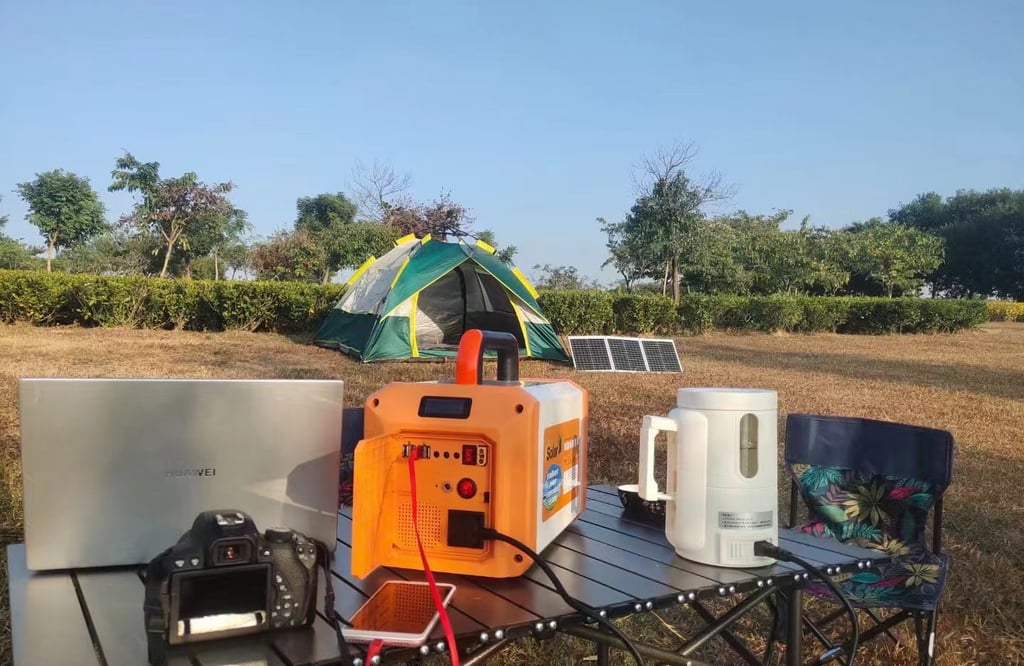Choosing the Right Portable Power Station: Understanding Capacity, Power, and Charging Methods
1/26/20255 min read


Understanding Capacity: What Does It Mean?
Capacity is a fundamental concept that plays a crucial role in assessing the performance of portable power stations. It is typically measured in watt-hours (Wh) or amp-hours (Ah). Watt-hours refer to the amount of energy that a power station can deliver over time—essentially, a measurement of how much electrical work can be done. Amp-hours, on the other hand, represent the flow of electric charge over a specific time period. Understanding these measurements allows potential users to evaluate the amount of power available from a portable power station.
The capacity of a portable power station directly influences its ability to power various devices, from small electronics like smartphones to larger appliances such as refrigerators. For example, a power station with a capacity of 500 watt-hours can run a 100-watt device for approximately five hours. This essential capacity metric assists users in planning for outdoor adventures or emergencies, where knowing how long devices can be powered can significantly impact experience and comfort levels.
In addition to simply measuring the amount of electricity available, capacity also affects the duration and efficiency of powering multiple devices simultaneously. It is important to consider what devices will be powered, their wattage requirements, and how long they will be in use. For outdoor enthusiasts or those preparing for emergencies, accurately assessing power needs based on capacity translates into more effective preparation and peace of mind during unforeseen circumstances.
Ultimately, understanding capacity in portable power stations empowers users to make informed decisions regarding their power needs, ensuring that they choose a product that aligns with their lifestyle and expectations. This understanding builds the foundation for effectively harnessing the power station's capabilities in various situations.
Power Output: Assessing Your Needs
When selecting a portable power station, understanding the power output specifications is vital to ensure that it meets your specific energy requirements. Two key measurements to consider are peak power and continuous power. Peak power, often referred to as surge power, is the maximum amount of power the unit can supply for a short duration, typically a few seconds. This is crucial for devices that require a higher initial power draw to start functioning, such as power tools or refrigerators. On the other hand, continuous power represents the maximum wattage the power station can sustain over a longer period, which is essential for devices that operate continuously, like lights or small appliances.
Knowing the distinction between these two measurements allows users to choose a portable power station that aligns with their needs. For instance, a power tool might have a starting wattage that exceeds the continuous wattage of a portable station, risking potential overload. Therefore, users should take into account both the surge and continuous requirements of their devices when making a selection. It is advisable to check the manufacturer’s specifications for each device you plan to use, as this will provide clarity on how much energy each requires.
Furthermore, the total wattage needed for your devices can influence your choice of a portable power station significantly. It is essential to add up the wattages of all devices to ascertain the minimum power output necessary for your power station. Overloading a power station can lead to circuit failures or damage to both the devices and the power station itself. By carefully assessing your power needs and matching them with the correct output specifications, you can ensure reliable and safe operations for all of your powered devices during outdoor activities, emergencies, or travel.
Charging Methods: A Comprehensive Overview
Portable power stations have become essential tools for outdoor enthusiasts and individuals seeking reliable backup power. Understanding the various charging methods available for these devices is pivotal to optimize their performance. The most common methods of charging include conventional AC wall charging, solar charging, and car charging, each offering distinct advantages and disadvantages.
AC wall charging is the most familiar method, utilizing standard electrical outlets. This approach generally provides faster charging times, allowing users to recharge their portable power stations to full capacity quickly. However, the reliance on proximity to electrical outlets can limit flexibility, especially in remote locations where access to power is restricted. Additionally, charging speeds can vary based on the overall capacity of the power station; higher capacity units tend to take longer to charge fully.
In contrast, solar charging has gained popularity due to its eco-friendly nature and independence from the grid. This method requires a solar panel, which harnesses sunlight to generate power. While solar charging offers sustainability, it is significantly affected by weather conditions and may take longer to recharge a power station compared to conventional methods. The efficiency of solar charging can vary based on the wattage of the solar panel and the amount of sunlight available, emphasizing the need for adequate planning during outdoor adventures.
Car charging is another convenient option, especially for users who are on the go. This method utilizes a car's power outlet and is beneficial for maintaining portable power stations while traveling. However, similar to AC wall charging, car charging can be slower, dependant on the vehicle's battery capacity and the power station's requirements.
To maximize efficiency regardless of the method used, it is advisable to monitor charging times and ensure compatibility between devices. Having multiple charging options allows for greater flexibility, empowering users to keep their portable power stations charged under various circumstances. Understanding these charging methods contributes significantly to the effective use of portable power stations.
Making an Informed Decision: Key Considerations
When deciding on the right portable power station, several critical factors must be carefully assessed to ensure that the chosen model aligns with individual needs and lifestyle requirements. First and foremost is the capacity of the power station, typically measured in watt-hours (Wh), which indicates how much energy the device can store. A higher capacity allows for powering multiple devices for extended periods, making it essential to consider the total wattage of the devices intended for use. It is advisable to account for peak power output as well, which refers to the maximum amount of power that can be drawn from the unit at any given moment.
Another fundamental aspect is the charging methods available. Many portable power stations can be charged through traditional wall outlets, solar panels, or even car ports, thus providing versatility for various situations. Consumers should evaluate their access to these power sources and how often they will rely on each, as this can significantly affect usability and convenience.
Other important considerations include mobility and weight. Depending on where and how the power station will be used, portability may play a crucial role. Models that are lightweight and compact often enhance usability, especially for outdoor activities such as camping or during emergency situations. Additionally, brand reputation should not be overlooked. Established brands tend to provide better customer service, warranty options, and product reliability.
Finally, budget considerations are paramount, as portable power stations come at various price points. It is advisable to compare the features and specifications of different models in relation to their costs. Reading customer reviews can also provide insight into real-world performance and durability, enabling consumers to make an informed purchasing decision. By weighing these key factors, individuals can select a portable power station that best serves their unique needs.
